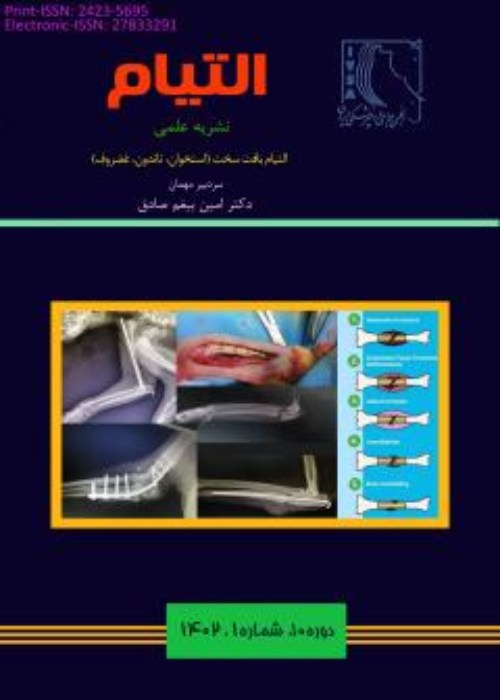Adrenal glands: diseases and laboratory diagnostic methods in small animals
Author(s):
Article Type:
Research/Original Article (ترویجی)
Abstract:
The adrenal glands are important organs in the body of small animals, which disruptions associated with their performance due to lack of timely detection in most cases, result in irreparable damage or death of the animal. The tissue structure of these glands is unique and the cortical and internal parts of these glands are responsible for secreting important hormones in the animal's body. In general, important functional diseases among adrenal gland diseases in small animals can be classified into two categories. The first category is the diseases caused by excessive proliferation and excessive growth of the adrenal gland, called hyperadrenocorticism, or cushing's syndrome/disease, and other diseases caused by low activity of adrenal glands that are known as Hypoadrenocorticism or Addison's syndrome/disease. Hyperadrenocorticism is primarily a disease of old dogs and ferrets, but it also occurs rarely in cats. Polyuria and polydipsia, lethargy, pot-belly and alopecia, are among the most frequent clinical signs. A stress leukogram (leukocytosis, mature neutrophilia, lymphopenia, eosinopenia, and monocytosis), increased alkaline phosphatase (ALP) and urine specific gravity <1.020 are good indicators of suspicion to Cushing’s disease. Increased urine cortisol: creatinine ratio (UCCR) in a dog that has classical signs and lab data of Cushing’s is very suggestive of hyperadrenocorticism. If the history, clinical signs, and routine laboratory data are suggestive for hyperadrenocorticism then the diagnosis at this stage is a two-step process: first rule in or rule out hyperadrenocorticism with screening tests [Low Dose Dexamethasome Suppression Test (LDDST) and ACTH stimulation test] and then try to differentiate pituitary and adrenal dependent hyperadrenocorticism with confirmatory tests [blood ACTH concentration and High Dose Dexamethasome Suppression Test (HDDST)]. Addison’s disease usually occurs in young to middle aged (3–6 years) dogs. Lethargy, weakness, vomiting, diarrhea, abdominal pain, anorexia, bradycardia, microcardia, decreased blood pressure, polyuria and polydipsia are the most constant clinical signs of the disease. Laboratory findings including azotemia, decreased urine specific gravity, absence of a stress leukogram and especially a Na: K ratio <23:1 are the key abnormalities to indicate primary hypoadrenocortisim. In such cases, blood cortisol concentration and ACTH stimulation test could be used for diagnosis of Addison’s disease. To differentiate pituitary and adrenal dependent hypoadrenocorticism, the concentration of blood ACTH should be measured.
Keywords:
Language:
Persian
Published:
Journal of Eltiam, Volume:5 Issue: 1, 2018
Pages:
66 to 85
magiran.com/p1907581
دانلود و مطالعه متن این مقاله با یکی از روشهای زیر امکان پذیر است:
اشتراک شخصی
با عضویت و پرداخت آنلاین حق اشتراک یکساله به مبلغ 1,390,000ريال میتوانید 70 عنوان مطلب دانلود کنید!
اشتراک سازمانی
به کتابخانه دانشگاه یا محل کار خود پیشنهاد کنید تا اشتراک سازمانی این پایگاه را برای دسترسی نامحدود همه کاربران به متن مطالب تهیه نمایند!
توجه!
- حق عضویت دریافتی صرف حمایت از نشریات عضو و نگهداری، تکمیل و توسعه مگیران میشود.
- پرداخت حق اشتراک و دانلود مقالات اجازه بازنشر آن در سایر رسانههای چاپی و دیجیتال را به کاربر نمیدهد.
In order to view content subscription is required
Personal subscription
Subscribe magiran.com for 70 € euros via PayPal and download 70 articles during a year.
Organization subscription
Please contact us to subscribe your university or library for unlimited access!


